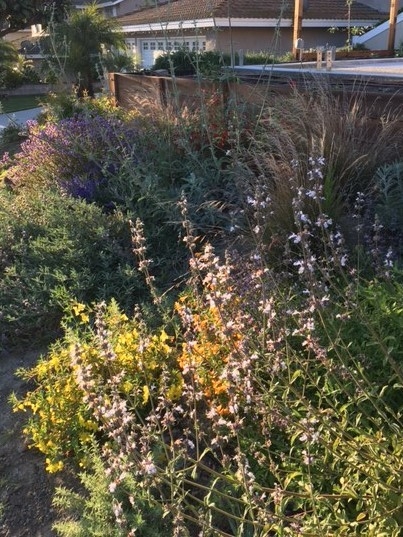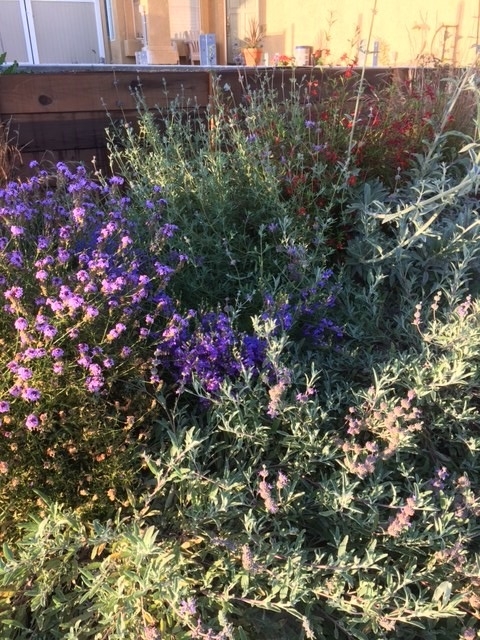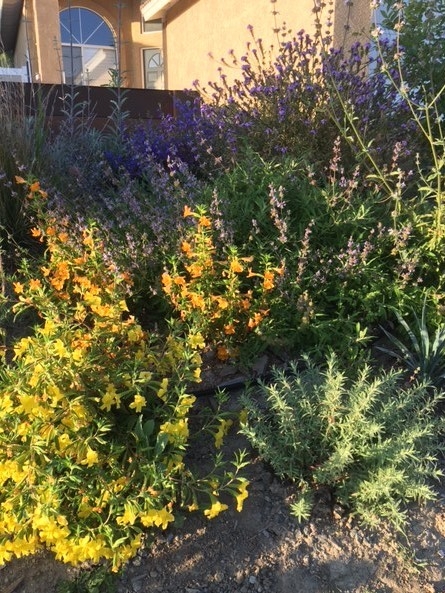Using California Natives
By Michael Bains
True California native plants are not something you normally find at your local big box store or large chain type garden center. While the plants sold in those places will most likely do just fine in your yard, there are many reasons to use California native plants, even if you need to put in a little extra work to locate them.
Easy Soil Preparation

Most of the plants in the picture to the left have been in the ground for just over a year. They are in full bloom and have increased in size tenfold from the 4 inch pots they were planted from. They are planted just in front of a retaining wall on a gentle slope to the side walk. This area used to be lawn. The lawn was removed and nothing else was done to the soil other than digging holes and dropping in the plants.
In fact, for many California natives adding amendments to the soil can inhibit their growth as they don't grow well in very rich soils.
Wildlife Adapted to Them
Local wildlife is well adapted to our native plant species and many use them as a food source and breeding ground. Examples of this can be seen with our local butterfly species.
Monarch butterflies will only lay eggs on milkweed (Asclepias L.), which is native to California. If a Monarch is unable to locate milkweed, they simply will not lay any eggs. Monarch caterpillars will feed on the milkweed as they grow. The milkweed contains toxic chemicals that make the caterpillars taste bad to birds.
Pipevine swallowtails use California Dutchman's Pipe (Aristolochia californica) as the host plant for their eggs. Caterpillars feed off the flowers that offer them the same chemical protection as monarchs receive from milkweed.
Lower Water Requirements

Native plants will grow well and continue to bloom well into the summer with limited water. A deep watering once or twice per month depending on how hot the weather is will keep native plants happy and performing throughout the year.
Lower Maintenance
California natives are already adapted to our California climate and terrain. For this reason, there are some things they don't require that will make maintenance much less time consuming.
First, when it comes to planting, they do not require any amendments, as stated previously. The best way to plant natives is to dig a hole twice the width of the container they are in and only as deep as the level of the soil in their pot. Break up the soil for a few inches further down in the hole after you've reached the desired depth. This will help the roots expand out. Place the plant in the hole so the level of the root ball is at or slightly above the level of the surrounding soil. Before backfilling with the soil you removed from the hole take a moment to break that soil apart, especially if there are large clumps of soil in it. I use a 5-gallon bucket and break the soil down well. After that, place that soil back into the hole, lightly pressing down on it to work out as much air as you can. Then, water the new planting deeply. You want to get the water down below the root ball. It takes a bit of time to do that.
Second, natives require no extra fertilizer. They get everything they need from the native soil, if you have selected a plant that's right for your area. We'll go over that in a future post.
Lastly, natives have developed their own defenses against pests. There should not be a reason to use pesticides on natives. In my garden, I have not used a single pesticide on my ornamental plants in over ten years of gardening there. (Now, powdery mildew on my pumpkins is a whole other story.)
After letting you know what natives don't need let me add one that they do much better with. Mulch. Lots of mulch, at least a good three inches. Four is better. This will help keep moisture in the soil and keep the soil temperature down. It will also suppress weeds lowering your maintenance requirements even further. This will make your garden much happier during our hot dry summer months.
Near the end of the summer, or after blooming, prune your natives back to your desired size, keeping in mind they will burst forth again during the winter and spring.
Longer Blooms

I certainly hope I've been able to whet your appetite for California natives. Unfortunately, they don't seem to get as much love as they should. So, please hunt these natives down, if you can. You won't be disappointed.
As an aside, there are several California native plant nurseries in Southern California including the Rancho Santa Ana Botanical Garden in Claremont, the Theodore Payne Foundation in Sun Valley and the Las Pilitas Nursery in Santa Margarita.